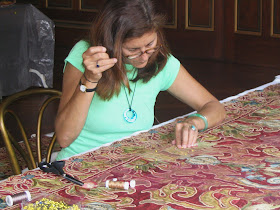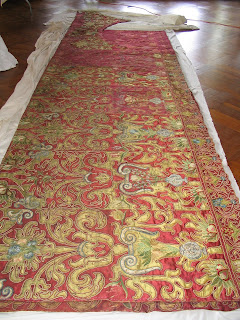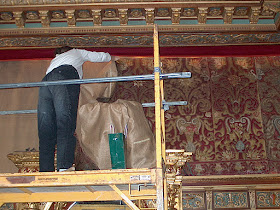By Noah Charney for ArtInfo
ARCA’s Postgraduate Certificate Program in Art Crime and Cultural Heritage Protection Studies is now taking applications for its fourth season as the first, and only, interdisciplinary program of study in the field of art crime and cultural heritage protection. Featured in The New York Times mid-way through its first year, in the summer of 2009, it is a good moment to reflect on the founding of this new and unusual academic program.
The idea for the program began with a conversation at a restaurant in Ljubljana, Slovenia with two trustees and friends, both professors of criminology. The problem was how to attract world-renowned faculty without the infrastructure or funds for a year-long program of study. It was important to retain quality-control by not simply running this unique program through a university, and yet we wanted to include as many of the best of the relatively few world experts in art crime and its related fields as we could. We also wanted a program that would be post-graduate level, and which would include as many or more course hours as normal, year-long European masters program. Having completed two European MA programs myself in art history (at The Courtauld Institute and University of Cambridge), I realized that the taught component to these programs actually took a relatively concise amount of time that was spread over 9-12 months. At The Courtauld Institute, the MA included twice-weekly meetings of 4 hours each over around 7 months (plus 2 months to write the dissertation), while at Cambridge the only required coursework was one 2-hour lecture per week—the rest of the time was one’s own, largely meant for research and writing of a substantial dissertation.
We decided that the scattered lecture hours, distributed over the course of many months, could reasonably be condensed into a concise period of time, for instance three months. By concentrating on intensive but acceptable 5-hour work days (2.5 hours in the morning, a generous lunch break, and 2.5 hours in the afternoon), we could create what is, logistically, a summer-intensive program that would run 10-11 weeks. This format also allowed us to invite world-class faculty, from professors to professionals, who would come to Italy to teach a short, intensive course. This worked with faculty schedules, because it did not require them to be on-site for more than two weeks at a time (our courses are 25 hours long, divided over 5 days within a two-week period). Coming up with this highly unusual format (10 professors each summer, two teaching in each two-week period, one Monday, Tuesday, and Wednesday morning, the other Wednesday afternoon, Thursday, and Friday), allowed us to recruit the best faculty we could, and to allow students (who in many cases are older professionals using this unique program as a means of further professional training) to undertake the program over a reasonable period of time, one summer. We also allow students to divide the program over two consecutive summers, 5-6 weeks each, with the understanding that this would ideally fit into active professional schedules, or indeed could be taken by students enrolled full-time in another post-graduate program, but with a summer free.
Such was the discussion that we had in Ljubljana back in 2007, that led to the ARCA Postgraduate Certificate Program.
The program was established in 2009 when ARCA and its trustees realized that there was not one academic program available anywhere in the world in which students and professionals could study art crime. Individual courses had existed, but appeared rarely on curricula. But one of the difficulties, and exciting aspects, of studying art crime is that it is inherently interdisciplinary. To understand art crime, one must approach it theoretically as well as practically. A purely theoretical, scholarly program which provided no sense what was happening in “real life,” in the field, at night in the museums and countryside churches so often the victim of theft. But a course of study which solely explored the practical side of things, such as Italian police investigation techniques, ran the risk of being overly specific, teaching only based on the experience of the teacher and the country in which they worked. The ideal course of study would embrace the inherent interdisciplinary nature of the field, and would complement theoretical/historical courses with practical experiential courses. For example, last summer’s program includes courses on art policing and investigation taught by the former head of Scotland Yard’s Arts and Antiques Unit (Dick Ellis) and the current head of Chubb International Art Insurance (Dorit Straus); but students also took a course on criminology, art, and organized crime taught by a world-famous criminology professor (Petrus van Duyne).
ARCA has become a point of union for the relatively few scholars, police, security experts, lawyers, archaeologists, insurers, and others around the world affected by art crime. The Postgraduate Certificate Program is a unique opportunity for students to learn from the top professionals and professors in the fields relevant to art crime and cultural heritage protection.
Because of its unique and ground-breaking nature, the ARCA Postgraduate Program was featured in The New York Times (21 July 2009), midway through its first year. It has since established itself and continues to attract passionate students and adult professionals from around the world to spend a summer studying with the world’s leading art crime experts in Italy.
The program provides in-depth, masters-level instruction in a wide variety of theoretical and practical elements of art and heritage crime: its history, its nature, its impact, and what can be done to curb it. Courses are taught by international experts, in the beautiful setting of Umbria, Italy. The topics taught include the history of art crime, art and antiquities law and policy, criminology, the laws of armed conflict, the art trade, art insurance, art security and policing, risk management, criminal investigation, law and policy, vandalism and iconoclasm, and cultural heritage protection throughout history and around the world.
Recent lecturers and faculty include: Maurizio Fiorilli (Advocate General of Italy), Francesco Rutelli (former Italian Minister of Culture and Mayor of Rome), Vernon Rapley (Director of Scotland Yard Arts and Antiques Unit), Col. Luigi Cortellessa (Vice-Comandante, Carabinieri Division for the Protection of Cultural Heritage), Matjaz Jager (Director of the Institute of Criminology, University of Ljubljana), Anthony Amore (Security Director, Isabella Stewart Gardner Museum), Stefano Alessandrini (Head of Italy’s Archaeological Group), Dennis Ahern (Security Director, Tate Museums, UK), Paolo Giorgio Ferri (leading attorney in the Giacomo Medici case and in repatriation cases with the Getty and the Met), and Peter Watson (acclaimed author and former undercover investigator against art theft). At the heart of the program is the ARCA International Conference in the Study of Art Crime (this year 23-24 June 2012), which gives students a chance to meet with top professionals in the field.
Past program graduates include art police and security professionals, lawyers, insurers, curators, conservators, members of the art trade, and post-graduate students of criminology, law, security studies, sociology, art history, archaeology, and history. About one-third of the students are adult professionals, while two-thirds are post-graduate students, ranging in age from 21 up to 65.
The 2012 program runs from June 1 to August 12. We have received more interest than ever for the program this fall, and students should apply early for better chance of admission. For a complete schedule and prospectus, or with any questions, you can email education (at) artcrimeresearch.org

























